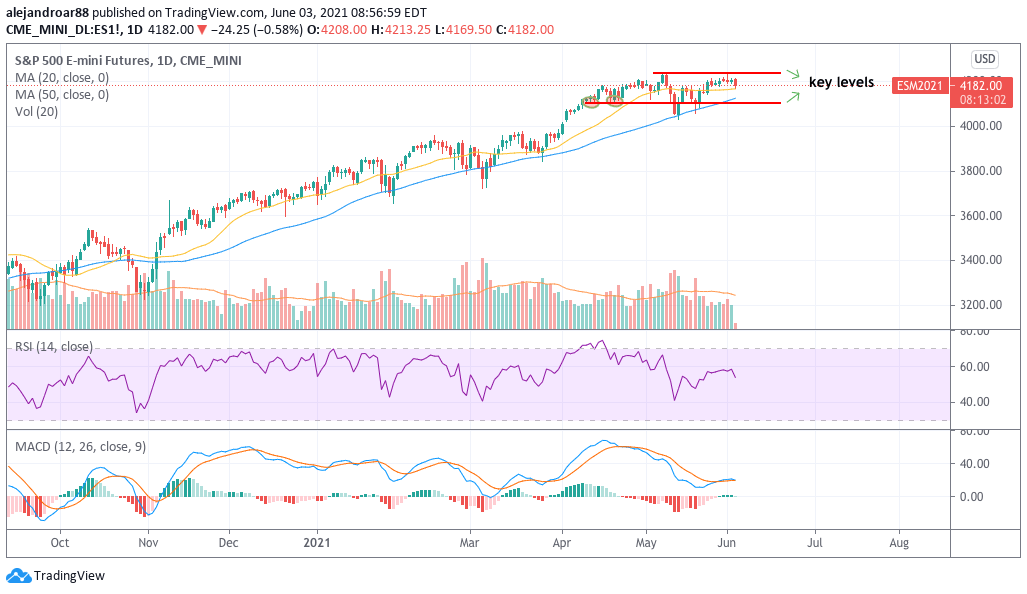US stock futures are heading lower today in early futures trading action after the Federal Reserve announced that it plans to unwind a small portion of its corporate bond portfolio while the market awaits the release of key labor market data.
Futures of the tech-heavy Nasdaq 100 are leading today’s downtick as they are retreating 1.05% at 13,531, followed by futures of the S&P 500, which are dropping 0.81% at 4,172. Meanwhile, E-mini futures of the Dow Jones Industrial Average are down 0.7% at 34,342.
The Federal Reserve announced yesterday that it plans to begin unwinding its portfolio of corporate bonds purchased under the Second Market Corporate Credit Facility (SMCCF), an emergency fund launched at the onset of the pandemic to support large companies in securing funding during the crisis.
According to the press release, the US central bank will gradually sell these assets based on the market’s liquidity and trading conditions. The portfolio of instruments held by the fund include bonds from Apple (AAPL) and Amazon (AMZN) and exchange-traded funds (ETF) holding a basket of fixed-income issues.
As of April 2021, the balance held by the SMCCF was $13.8 billion. While the amount is considered too small to generate a large degree of instability in the bond market, the Fed’s decision to start unwinding some of its positions marks a turning point and could signal a less accommodative stand from the central bank in the coming months.
This move comes as indications that inflation is accelerating in multiple corners of the country were further revealed in the Fed’s Beige Book, which was published yesterday as well. Officials from most branches of the central bank reported higher commodity prices in their jurisdictions while companies in New York and other states expect that prices will continue to rise in the coming months.
Increased concerns about inflation possibly spinning out of control could force the Fed to progressively taper its monthly $120 billion asset purchases and this decision to unwind its catalog of corporate bonds could be the first of many upcoming efforts to reduce the size of the central bank’s balance sheet in the near future.
Earlier today, CNBC reported that Russia’s National Wealth Fund (NWF) will be getting rid of all its dollar assets while turning to the euro, Chinese yuan, and gold. As of 1 May, the fund had a total of $186 billion in assets including dollar-denominated instruments.
Heading to Friday’s key jobs report, data from Automatic Data Processing (ADP) reported this morning that a total of 978,000 Americans were hired in May – a significant jump compared to the market’s consensus estimate of 680,000 new jobs for the period.
Although ADP data does not always predict with accuracy the numbers to be published in the official jobs report, market participants find it useful to reaffirm directional estimates. Meanwhile, the Labor Department just reported that weekly jobless claims fell to 385,000, down from a total of 405,000 reported last week. Economists were expecting a slighter decline at 393,000.
Despite these upbeat reports, US stock futures continue to drift lower as inflation and tapering worries seem to be persisting.
What’s next for US stock futures?

The latest price action seen by S&P 500 futures show that the benchmark has been trading range-bound since the beginning of May while it has failed to move above the 4,250 area at least three times this month.
This consolidation is not necessarily positive as it marks a slowdown in the latest uptrend, possibly as market participants are struggling to determine which direction the market will take in the following months based on the current environment.
Tapering and inflation fears could dominate the narrative in the following weeks if more indications from the Fed point in this direction. In that context, the path of least resistance for the S&P 500 seems to be down.
For now, the key levels to watch are 4,250 for bulls and 4,000 for bears. A break above the upper boundary of this consolidation rectangle could signal the continuation of the former uptrend while a move below that key psychological area of support could lead to a sharp correction for the index.
Trusted & Regulated Stock & CFD Brokers
What we like
- 0% Fees on Stocks
- 5000+ Stocks, ETFs and other Markets
- Accepts Paypal Deposits
Min Deposit
$200
Charge per Trade
Zero Commission on real stocks
64 traders signed up today
Visit Now67% of retail investor accounts lose money when trading CFDs with this provider. You should consider whether you can afford to take the high risk of losing your money.
Available Assets
- Total Number of Stocks & Shares5000+
- US Stocks
- German Stocks
- UK Stocks
- European
- ETF Stocks
- IPO
- Funds
- Bonds
- Options
- Futures
- CFDs
- Crypto
Charge per Trade
- FTSE 100 Zero Commission
- NASDAQ Zero Commission
- DAX Zero Commission
- Facebook Zero Commission
- Alphabet Zero Commission
- Tesla Zero Commission
- Apple Zero Commission
- Microsoft Zero Commission
Deposit Method
- Wire Transfer
- Credit Cards
- Bank Account
- Paypall
- Skrill
- Neteller
What we like
- Sign up today and get $5 free
- Fractals Available
- Paypal Available
Min Deposit
$0
Charge per Trade
$1 to $9 PCM
Visit Now
Investing in financial markets carries risk, you have the potential to lose your total investment.
Available Assets
- Total Number of Shares999
- US Stocks
- German Stocks
- UK Stocks
- European Stocks
- EFTs
- IPOs
- Funds
- Bonds
- Options
- Futures
- CFDs
- Crypto
Charge per Trade
- FTSE 100 $1 - $9 per month
- NASDAQ $1 - $9 per month
- DAX $1 - $9 per month
- Facebook $1 - $9 per month
- Alphabet $1 - $9 per month
- Telsa $1 - $9 per month
- Apple $1 - $9 per month
- Microsoft $1 - $9 per month
Deposit Method
- Wire Transfer
- Credit Cards
- Bank Account




